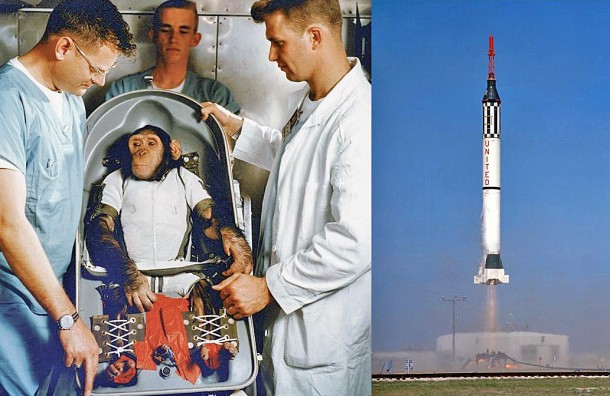
Fifty-four years ago this month, NASA successfully conducted a critical flight test of the space agency’s Mercury-Redstone launch vehicle which helped clear the way for the United States’ first manned suborbital spaceflight. Riding the diminutive Mercury spacecraft into space and back was a 44-month old male chimpanzee by the name of HAM.
Project Mercury was America’s first manned spaceflight program. Simply put, Mercury helped us learn how to fly astronauts in space and return them safely to earth. A total of six (6) manned missions were flown between May of 1961 and May of 1963. The first two (2) flights were suborbital shots while the final four (4) flights were full orbital missions. All were successful.
The Mercury spacecraft weighed about 3,000 lbs, measured 9.5-ft in length and had a base diameter of 6.5-ft. Though diminutive, the vehicle contained all the systems required for manned spaceflight. Primary systems included guidance, navigation and control, environmental control, communications, launch abort, retro package, heatshield, and recovery.
Mercury spacecraft launch vehicles included the Redstone and Atlas missiles. Both were originally developed as weapon systems and therefore had to be man-rated for the Mercury application. Redstone, an Intermediate Range Ballistic Missile (IRBM), was the booster for Mercury suborbital flights. Atlas, an Intercontinental Ballistic Missile (ICBM), was used for orbital missions.
Early Mercury-Redstone (MR) flight tests did not go particularly well. The subject missions, MR-1 and MR-1A, were engineering test and development flight tests flown with the intent of man-rating both the converted launch vehicle and new manned spacecraft.
MR-1 hardly flew at all in that its rocket motor shut down just after lift-off. After soaring to the lofty altitude of 4-inches, the vehicle miraculously settled back on the launch pad without toppling over and detonating its full load of propellants. MR-1A flew, but owing to higher-than-predicted acceleration, went much higher and farther than planned. Nonetheless, MR flight testing continued in earnest.
The objectives of MR-2 were to verify (1) that the fixes made to correct MR-1 and MR-1A deficiencies indeed worked and (2) proper operation of a bevy of untested systems as well. These systems included environmental control, attitude stabilization, retro-propulsion, voice communications, closed-loop abort sensing and landing shock attenuation. Moreover, MR-2 would carry a live biological payload (LBP).
A 44-month old male chimpanzee was selected as the LBP. He was named HAM in honor of the Holloman Aerospace Medical Center where the primate trained. HAM was taught to pull several levers in response to external stimuli. He received a banana pellet as a reward for responding properly and a mild electric shock as punishment for incorrect responses. HAM wore a light-weight flight suit and was enclosed within a special biopack during spaceflight.
On Tuesday, 31 January 1961, MR-2 lifted-off from Cape Canaveral’s LC-5 at 16:55 UTC. Within one minute of flight, it became obvious to Mission Control that the Redstone was again over-accelerating. Thus, HAM was going to see higher-than-planned loads at burnout and during reentry. Additionally, his trajectory would take him higher and farther downrange than planned. Nevertheless, HAM kept working at his lever-pulling tasks.
The Redstone burnout velocity was 5,867 mph rather than the expected 4,400 mph. This resulted in an apogee of 137 nm (100 nm planned) and a range of 367 nm (252 nm predicted). HAM endured 14.7 g’s during entry; well above the 12 g’s planned. Total flight duration was 16.5 minutes; several minutes longer than planned.
Chillingly, HAM’s Mercury spacecraft experienced a precipitous drop in cabin pressure from 5.5 psig to 1 psig just after burnout. High flight vibrations had caused the air inlet snorkel valve to open and dump cabin pressure. HAM was both unaware of and unaffected by this anomaly since he was busy pulling levers within the safety of his biopack.
HAM’s Mercury spacecraft splashed-down at 17:12 UTC about 52 nm from the nearest recovery ship. Within 30 minutes, a P2V search aircraft had spotted HAM’s spacecraft (now spaceboat) floating in an upright position. However, by the time rescue helicopters arrived, the Mercury spacecraft was found floating on its side and taking on sea water.
Apparently, a combination of impact damage to the spacecraft’s pressure bulkhead and the open air inlet snorkel valve resulted in HAM’s spacecraft taking on roughly 800 lbs of sea water. Further, heavy ocean wave action had really hammered HAM and the Mercury spacecraft. The latter having had its beryllium heatshield torn away and lost in the process.
Fortunately, one of the Navy rescue helicopters was able to retrieve the waterlogged spacecraft and deposit it safely on the deck of the USS Donner. In short order, HAM was extracted from the Mercury spacecraft. Despite the high stress of the day’s spaceflight and recovery, HAM looked pretty good. For his efforts, HAM received an apple and an orange-half.
While the MR-2 was judged to be a success, one more flight would eventually be flown to verify that the Redstone’s over-acceleration problem was fixed. That flight, MR-BD (Mercury-Redstone Booster Development) took place on Friday, 24 March 1961. Forty-two (42) days later USN Commander Alan Bartlett Shepard, Jr. became America’s first astronaut.
MR-2 was HAM’s first and only spaceflight experience. He quietly lived the next 17 years as a resident of the National Zoo in Washington, DC. His last 2 years were spent living at a North Carolina zoo. On Monday, 19 January 1983, HAM passed away at the age of 26. HAM is interred at the New Mexico Museum of Space History in Alamogordo, NM.
